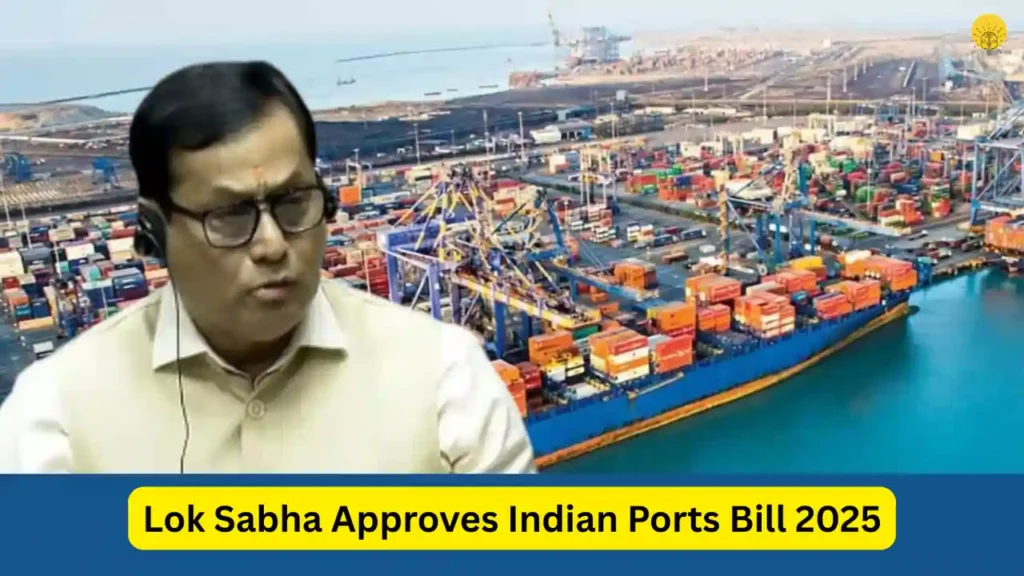New Delhi: On August 12, 2025, the Lok Sabha passed the transformative Indian Ports Bill, 2025, a comprehensive legislative measure designed to overhaul India’s port sector. Replacing the antiquated Indian Ports Act of 1908, this bill introduces a modern framework to enhance port governance, streamline operations, and position India as a leading global maritime hub. Passed through a voice vote despite opposition protests, the legislation is set to drive economic growth, sustainability, and cooperative federalism in the maritime domain.

A New Vision for India’s Ports
The Indian Ports Bill, 2025, aims to consolidate and modernize regulations governing India’s ports, addressing the shortcomings of the 1908 Act, which lacked provisions for contemporary planning, environmental protection, and efficient dispute resolution. With India’s 7,500-kilometer coastline serving as a critical economic asset, the bill seeks to optimize its potential through integrated development, digitalization, and enhanced ease of doing business (EoDB).
Core Features of the Legislation
- Maritime State Development Council (MSDC): The bill establishes the MSDC, led by the Union Minister for Ports, Shipping and Waterways as its ex-officio Chairperson. This council, comprising representatives from central and state governments, will drive coordinated strategies to ensure structured growth across the port sector.
- Empowering State Maritime Boards: The legislation grants statutory recognition to State Maritime Boards, enabling state governments to efficiently manage the 213 non-major ports under their control. This decentralization strengthens local governance and fosters regional development.
- Streamlined Dispute Resolution: State governments are required to set up Dispute Resolution Committees (DRCs) to address conflicts related to non-major ports. Appeals from DRC rulings will be directed to the High Court, bypassing civil courts to expedite resolutions.
- Transparent Tariff Structures: For major ports, tariffs will be set by the Board of Major Port Authority or the Board of Directors for ports governed under the Companies Act, 2013. State Maritime Boards will determine tariffs for non-major ports, promoting fairness and competitiveness.
- Port Notification and Mega Ports: The Central Government, in collaboration with state governments, will have the authority to designate new ports, modify port boundaries, and establish criteria for classifying certain ports as “mega ports,” facilitating large-scale infrastructure projects.
- Commitment to Sustainability and Safety: The bill aligns with global standards, including MARPOL and the Ballast Water Management Convention, mandating waste management facilities, pollution control measures, and emergency preparedness plans. Ports are encouraged to adopt renewable energy and shore power systems to minimize environmental impact.
- Holistic Management: The legislation encompasses critical areas such as pollution control, disaster response, security, safety, navigation, and data management, ensuring compliance with India’s international obligations.
India’s Port Landscape
India’s port infrastructure consists of 12 major ports, regulated by the Major Port Authorities Act, 2021, under the Ministry of Shipping, and 213 non-major ports managed by state entities. The Indian Ports Bill, 2025, promotes synergy between these segments through strategic planning and unified development goals.
Union Minister Sarbananda Sonowal’s Perspective
In the Lok Sabha debate, Union Minister Sarbananda Sonowal described the bill as a pivotal reform to align India’s maritime sector with 21st-century demands. He underscored the sector’s role as the backbone of India’s four-trillion-dollar economy, crediting Prime Minister Narendra Modi’s leadership for its progress.
Sonowal highlighted key achievements: port capacity has surged by 87% over the past decade, with cargo handling reaching an unprecedented 855 million tonnes. Coastal shipping has grown by 180%, reflecting significant operational improvements. He criticized the 1908 Act for its outdated framework and emphasized that the new bill prioritizes long-term planning and collaboration between the center and states.
“This legislation is a testament to our vision of ‘ports for prosperity,’ ensuring global competitiveness while prioritizing environmental sustainability and coastal community empowerment,” Sonowal stated. He expressed confidence that the bill will propel India toward becoming a top maritime nation by 2047.
Parliamentary Endorsements
Several parliamentarians endorsed the bill during the debate. BJP’s Dilip Saikia emphasized the 87% increase in port capacity over 11 years. TDP’s Sribharat Mathukumili commended the reduction in ship turnaround time from 93 hours to 48 hours at major ports and highlighted India’s improved international shipment ranking from 44 to 23 in 2023. BJP’s Darshan Singh Choudhary noted the cargo handling capacity of 855 million tonnes and praised the MSDC’s role in fostering a unified development strategy.
Economic and Environmental Benefits
The Indian Ports Bill, 2025, is poised to revolutionize India’s maritime sector by enhancing trade efficiency and reducing logistics costs. Digitalization and simplified procedures will improve EoDB, benefiting exporters and MSMEs by eliminating operational bottlenecks. The bill is expected to create numerous jobs in port operations, logistics, warehousing, and related sectors.
Sustainability is a key focus, with provisions for eco-friendly practices, including waste handling and pollution prevention, aligned with international standards. Renewable energy adoption and shore power systems will reduce emissions, contributing to a cleaner environment.
Ports will enjoy greater autonomy with accountability, enabling competitive tariff setting within a transparent framework. The bill supports long-term planning for cargo growth and improved hinterland connectivity. It also promotes coastal shipping by integrating with inland waterways and multimodal transport systems. Flexible funding mechanisms, including public-private partnerships (PPPs) and foreign investments, will fuel infrastructure development.
Passage Amid Parliamentary Tensions
The bill was passed on August 12, 2025, despite disruptions from opposition members demanding a discussion on Bihar’s electoral roll revisions. The Lok Sabha also passed the Mines and Minerals (Development and Regulation) Amendment Bill, 2025, on the same day.
Parliamentary Affairs Minister Kiren Rijiju condemned the opposition’s actions, including tearing documents in the House, describing them as disrespectful to the Chair and detrimental to the House’s dignity. He contrasted this with the BJP’s conduct during its time in opposition. Jagdambika Pal, presiding during the session’s second half, criticized Congress Deputy Leader Gaurav Gogoi for inciting members to disrupt proceedings.
Broader Context and Infrastructure Initiatives
The bill aligns with other infrastructure developments, such as the ₹25,000 crore shipbuilding fund approved by the Economic Advisory Council and plans for EV charging points at green ports. These initiatives underscore India’s commitment to sustainable economic growth.
Conclusion
The Indian Ports Bill, 2025, marks a historic step toward modernizing India’s port governance, boosting trade efficiency, and establishing India as a global maritime leader. By replacing colonial-era regulations, it aligns with Prime Minister Narendra Modi’s vision of a self-reliant, world-class maritime sector. With its emphasis on sustainability, cooperative federalism, and economic growth, the bill sets the stage for a future-ready maritime ecosystem, positioning India to become a top global maritime nation by 2047.
Frequently Asked Questions (FAQs)
1. What is the Indian Ports Bill, 2025, and what does it aim to achieve?
The Indian Ports Bill, 2025, is a transformative legislation passed by the Lok Sabha on August 12, 2025, replacing the outdated Indian Ports Act of 1908. It aims to modernize port governance, enhance trade efficiency, and position India as a global maritime leader. The bill promotes integrated port development, ease of doing business, sustainability, and cooperative federalism by establishing frameworks like the Maritime State Development Council and empowering State Maritime Boards.
2. What are the key features of the Indian Ports Bill, 2025?
The bill introduces several key provisions, including the creation of the Maritime State Development Council (MSDC) to coordinate port strategies, statutory recognition for State Maritime Boards to manage non-major ports, and Dispute Resolution Committees (DRCs) for swift conflict resolution. It also regulates port tariffs, allows the Central Government to notify new ports and classify “mega ports,” and ensures compliance with international environmental and safety standards like MARPOL and the Ballast Water Management Convention.
3. How does the bill address environmental and safety concerns?
The Indian Ports Bill, 2025, prioritizes sustainability by mandating waste reception facilities, pollution prevention measures, and emergency preparedness plans at ports. It aligns with international conventions such as MARPOL and promotes eco-friendly practices like renewable energy adoption and shore power systems to reduce emissions, ensuring ports contribute to a cleaner environment while maintaining safety standards.
4. What economic benefits does the Indian Ports Bill, 2025, offer?
The bill is expected to reduce logistics costs, enhance cargo movement, and improve connectivity, benefiting exporters and MSMEs through streamlined procedures and better infrastructure. It will create jobs in port operations, logistics, and warehousing. By fostering transparent tariff policies, public-private partnerships, and foreign investments, the bill enhances port competitiveness and supports long-term economic growth.
5. How does the bill promote cooperative federalism?
The bill strengthens collaboration between the Central and state governments through the Maritime State Development Council (MSDC), which coordinates national port development strategies. It empowers State Maritime Boards to manage non-major ports effectively, ensuring states have a significant role in port governance. This framework fosters a unified approach to port development, aligning state and central objectives for holistic growth.

